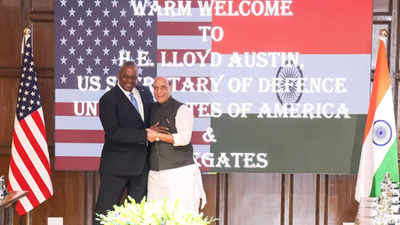- News
- India News
- India, US finalise roadmap for defence-industrial cooperation
Trending Topics
India, US finalise roadmap for defence-industrial cooperation

NEW DELHI: India and the US on Monday set the stage for clinching the mega project to co-produce fighter jet engines during PM Narendra Modi’s visit to Washington later this month, while also deciding to further strengthen operational military cooperation in the Indo-Pacific with an eye firmly on “the bullying and coercion” by China.
The delegation-level meeting between defence minister Rajnath Singh and US secretary of defence Lloyd Austin here concluded a new ambitious defence-industrial cooperation roadmap to fast-track technology collaboration and co-production of existing as well as futuristic weapon systems and platforms. The areas range from air combat, infantry combat vehicles and ISR (intelligence, surveillance, reconnaissance) systems to long-range artillery, smart munitions and underwater domain awareness.

The immediate takeaway will be the inking of the major pact between US company General Electric (GE) and defence PSU Hindustan Aeronautics to jointly produce GE-F414 turbofan engines in the 98 Kilonewton thrust class in India.
“There will be virtually 100% ToT (transfer of technology) for the GE-F414 engines, which will power the indigenous Tejas Mark-2 fighters (existing Tejas Mark-1 jets have less powerful GE-F404 engines procured without any ToT). Other projects like the co-production of Stryker armoured fighting vehicles, long-range artillery and ISR systems are in the discussion stage,” a source told TOI.
The roadmap is also likely to facilitate the ToT and setting up of MRO facilities that India is pushing for under the long-pending deal for acquisition of armed Predator or MQ-9B Sea Guardian drones.
During the delegation-level meeting, sources said India briefed the US on the “aggressive intent” shown by China along the 3,488-km line of actual control amid the continuing military confrontation in eastern Ladakh.
“India also underlined the fact that China and Pakistan act in collusion and should be seen as a single entity. Islamabad should not be trusted with western defence equipment,” a source said.
On the bilateral front, India and the US committed to collaborating even more closely in support of their “shared vision” for a free, open and inclusive Indo-Pacific. They also agreed to strengthen operational collaboration across all military services, with the aim to support India’s leading role as a security provider in the Indo-Pacific.
Austin said the deepening India-US partnership shows how growing military cooperation between the two “great powers” can be a force for global good.
Stressing that the US was not trying to establish a Nato-like structure in the Indo-Pacific, Austin said, “We continue to work with like-minded countries to ensure the region remains free and open so that commerce can prosper and ideas can continue to be exchanged.”
The new defence-industrial cooperation roadmap “aims to change the paradigm for cooperation” between the two countries..., the US statement said.
The delegation-level meeting between defence minister Rajnath Singh and US secretary of defence Lloyd Austin here concluded a new ambitious defence-industrial cooperation roadmap to fast-track technology collaboration and co-production of existing as well as futuristic weapon systems and platforms. The areas range from air combat, infantry combat vehicles and ISR (intelligence, surveillance, reconnaissance) systems to long-range artillery, smart munitions and underwater domain awareness.

03:05
Defence Minister Rajnath Singh holds a bilateral meeting US Defence Secretary Lloyd J Austin III
The immediate takeaway will be the inking of the major pact between US company General Electric (GE) and defence PSU Hindustan Aeronautics to jointly produce GE-F414 turbofan engines in the 98 Kilonewton thrust class in India.
“There will be virtually 100% ToT (transfer of technology) for the GE-F414 engines, which will power the indigenous Tejas Mark-2 fighters (existing Tejas Mark-1 jets have less powerful GE-F404 engines procured without any ToT). Other projects like the co-production of Stryker armoured fighting vehicles, long-range artillery and ISR systems are in the discussion stage,” a source told TOI.
The roadmap is also likely to facilitate the ToT and setting up of MRO facilities that India is pushing for under the long-pending deal for acquisition of armed Predator or MQ-9B Sea Guardian drones.
During the delegation-level meeting, sources said India briefed the US on the “aggressive intent” shown by China along the 3,488-km line of actual control amid the continuing military confrontation in eastern Ladakh.
“India also underlined the fact that China and Pakistan act in collusion and should be seen as a single entity. Islamabad should not be trusted with western defence equipment,” a source said.
On the bilateral front, India and the US committed to collaborating even more closely in support of their “shared vision” for a free, open and inclusive Indo-Pacific. They also agreed to strengthen operational collaboration across all military services, with the aim to support India’s leading role as a security provider in the Indo-Pacific.
Austin said the deepening India-US partnership shows how growing military cooperation between the two “great powers” can be a force for global good.
Stressing that the US was not trying to establish a Nato-like structure in the Indo-Pacific, Austin said, “We continue to work with like-minded countries to ensure the region remains free and open so that commerce can prosper and ideas can continue to be exchanged.”
The new defence-industrial cooperation roadmap “aims to change the paradigm for cooperation” between the two countries..., the US statement said.
Start a Conversation
FOLLOW US ON SOCIAL MEDIA
FacebookTwitterInstagramKOO APPYOUTUBE










